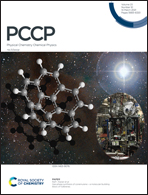Probing BrCl from photodissociation of CH2BrCl and CHBr2Cl at 248 nm using cavity ring-down spectroscopy
Abstract
Photodissociation of di- and tri-halogenated methanes including CH2BrCl and CHBr2Cl at 248 nm was investigated using cavity ringdown absorption spectroscopy (CRDS). The spectra of the BrCl(v′′ = 2, 3) and Br2(v′′ = 1, 2) fragments were probed over the wavelength range of 594.5–596 nm in the B3Π+0u ← X1Σ+g and B3Π (0+) ← X1Σ+ transitions, respectively. Their corresponding spectra were simulated for assignment of rotational lines at a given vibrational level. The quantum yields for Br2 eliminated from CHBr2Cl and BrCl from CH2BrCl were determined to be 0.048 ± 0.018 and 0.037 ± 0.014, respectively. The photodissociation of CHBr2Cl yielded only the Br2 fragment, but not the BrCl fragment in the experiments. An ab initio theoretical method based on the CCSD(T)//B3LYP/6-311g(d,p) level was employed to evaluate the potential energy surface for the dissociation pathways to produce Br2 and BrCl from CHBr2Cl, which encountered a transition state barrier of 445 and 484 kJ mol−1, respectively. The corresponding RRKM rate constants were calculated to show that the branching ratio of (Br2/BrCl) is ∼20. The BrCl spectrum is expected to be obscured by the much larger Br2 spectrum, explaining why BrCl fragments cannot be detected in the photolysis of CHBr2Cl.



 Please wait while we load your content...
Please wait while we load your content...